These soft sourdough pumpkin dinner rolls are the perfect way to dress up your holiday table!
Originally published on December 11th, 2020
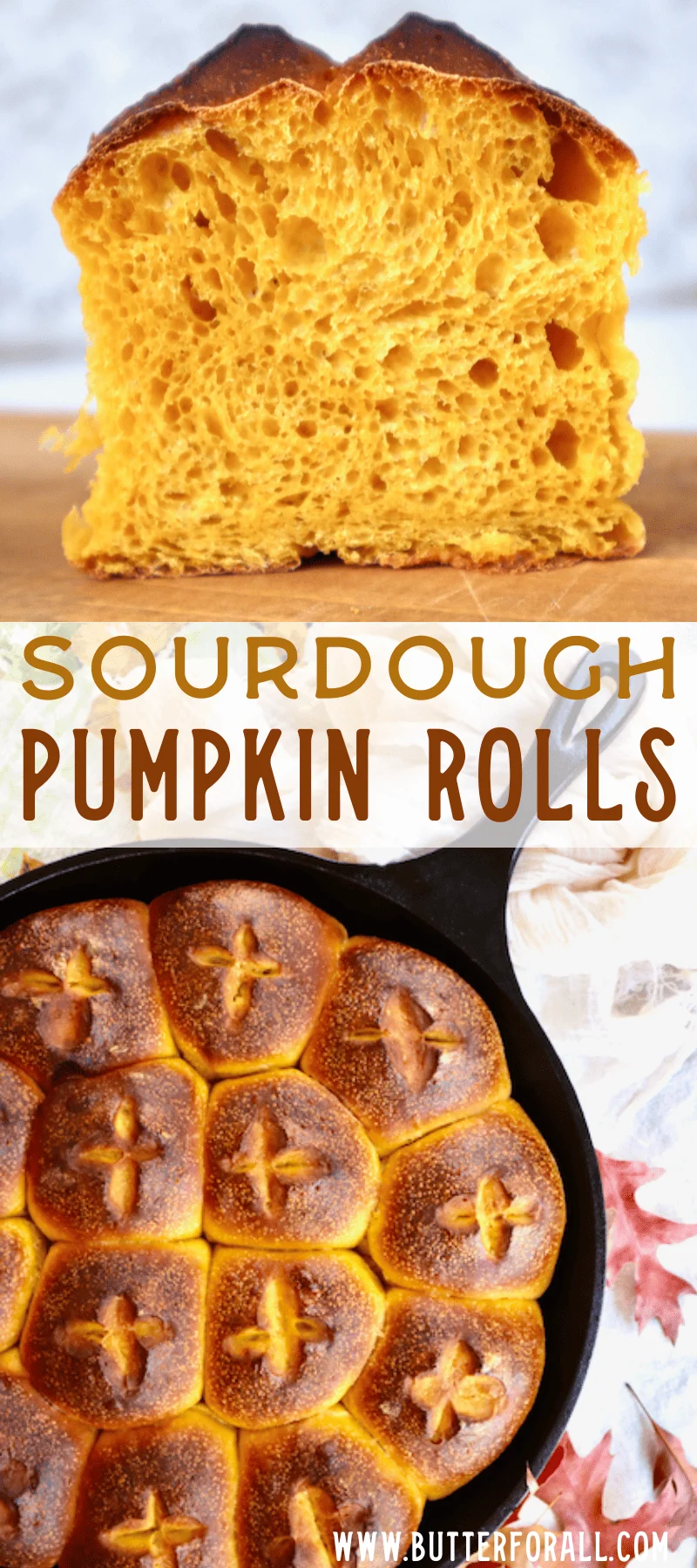
Made with all-natural ingredients like puréed pumpkin or winter squash, eggs, milk, cream, and low-glycemic coconut sugar, this recipe uses my classic overnight fermentation technique for the best flavor, texture, and digestibility.
I don’t think you will find a softer, more delicate sourdough pumpkin roll!
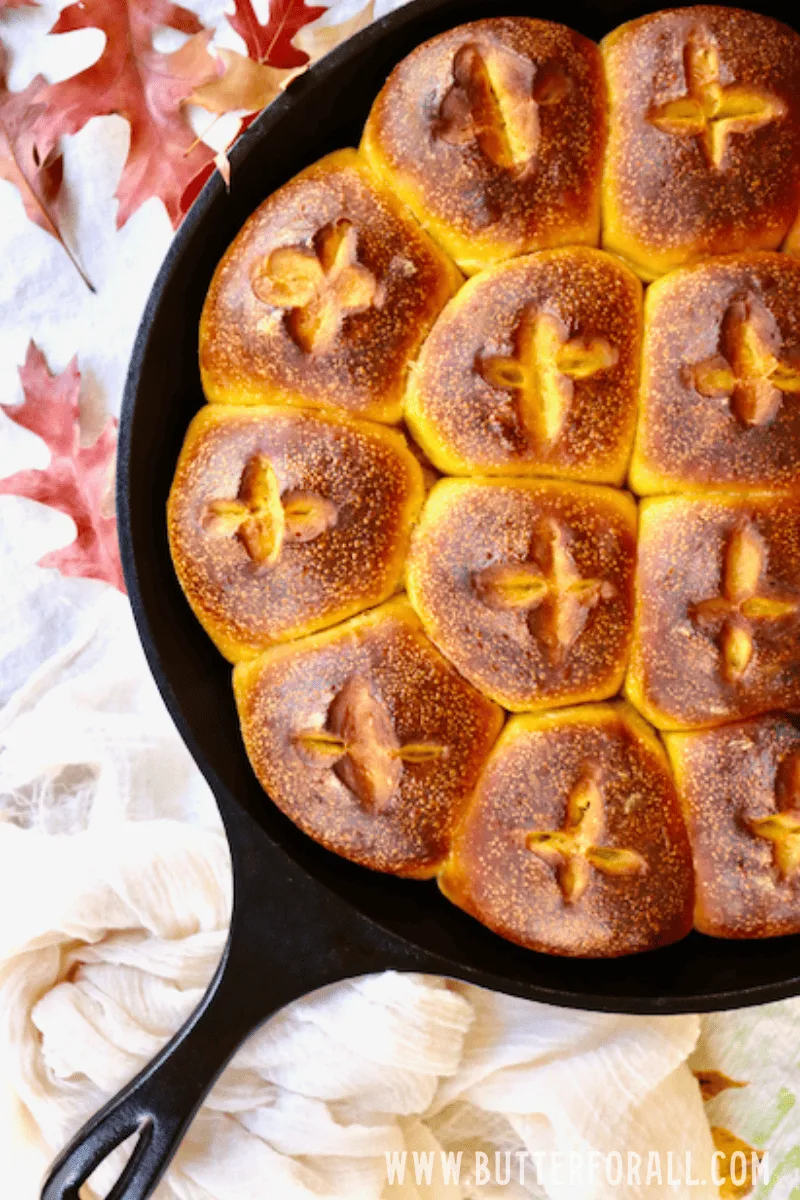
How to Roast Your Own Pumpkin for These Sourdough Pumpkin Dinner Rolls
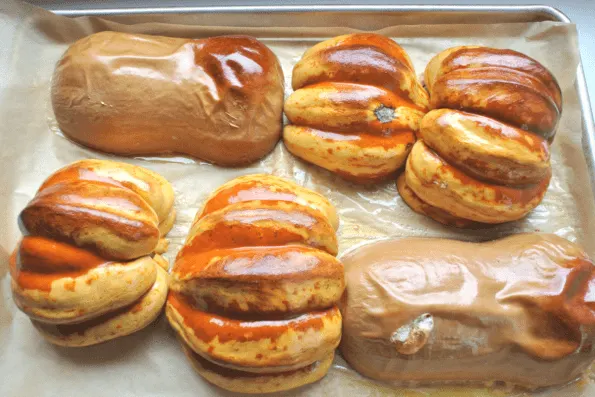
I like to use a variety of winter squash and pumpkin to make my own purée that will last the whole season.
Every 5 pounds of whole squash or pumpkin you roast will yield 5 to 6 cups of purée. I personally like to roast around 10 pounds and freeze the roasted, puréed meat in 2- to 3-cup portions.
Here’s how I do it:
- Preheat the oven to 350℉.
- Halve the squash or pumpkins and scrape out the seeds.
- Place them cut side down on a parchment-lined baking sheet.
- Bake them until fork tender and well roasted, about 60 to 90 minutes.
- Let them cool before scraping the flesh into your food processor.
- Purée the squash and pumpkin until smooth.
- Use, refrigerate, or freeze for future uses!
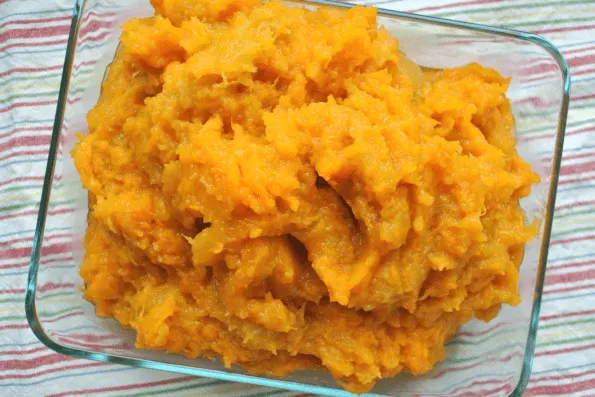
Make Plenty of This Purée so You Can Try My Favorite Pie!
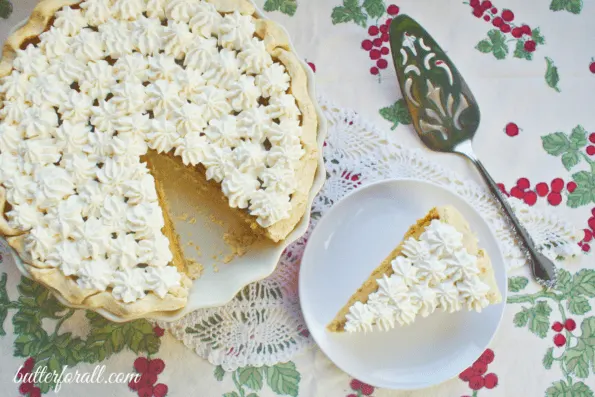
Date-Sweetened Winter Squash Pie With Maple Whipped Cream
No Time for Roasting Pumpkins?
You can use canned pumpkin purée! I won’t tell!
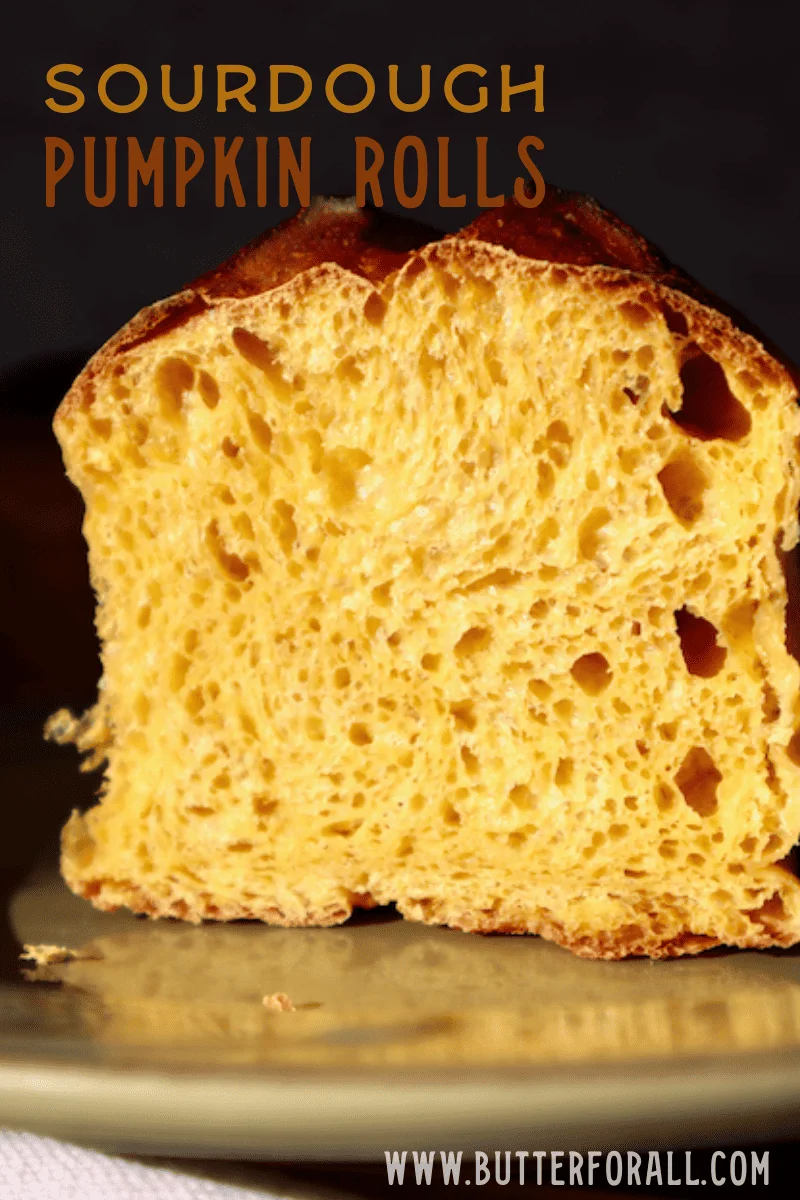
The Softest Sourdough Pumpkin Dinner Rolls Around
This recipe uses a rich dough. It includes milk, cream, eggs, sugar, and pumpkin. All these ingredients contribute to keeping the dough soft and squishy. The result is a light and airy roll with a striking pumpkin color and an earthy sweet flavor.
Because this dough includes eggs, any rolls not eaten the first day should be refrigerated and reheated in a low oven or toaster.
The leftovers make great French toast!
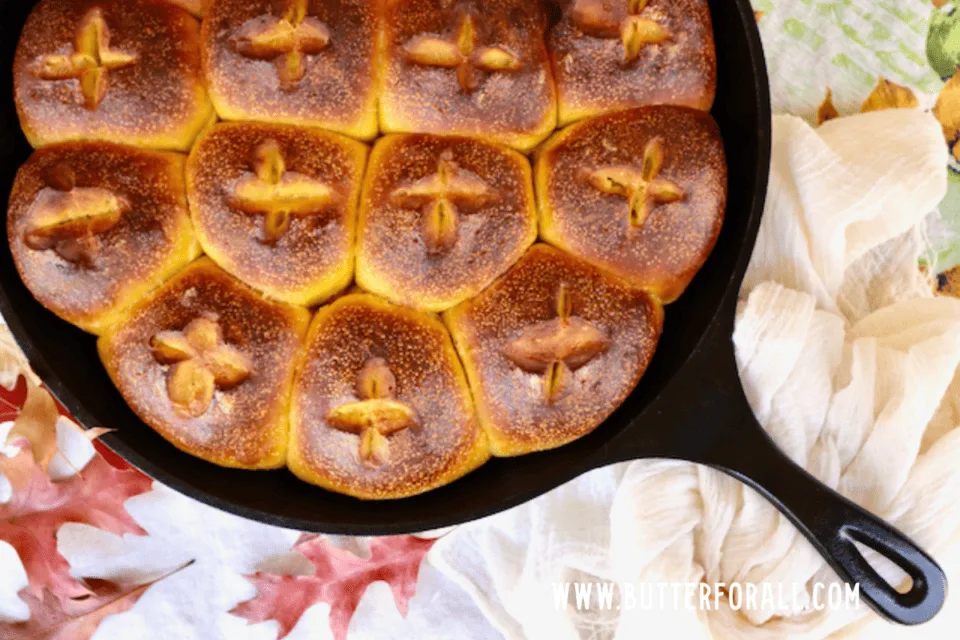
Shaping Sourdough Pumpkin Dinner Rolls
This recipe makes 16 extra-large dinner rolls (130g) or two dozen small rolls (85g) — perfect for sharing with family, friends, and neighbors!
They can be baked in two 10-inch cast-iron skillets, two 8-inch by 11.5-inch by 2-inch standard casserole dishes, or in one large 10 by 15-inch casserole dish or one deep 15-inch skillet (pictured).
These rolls really poof. Make sure you allow plenty of space around each roll for expansion but remember that they will stay softest if they are touching each other after proofing.
The dough can also be shaped and baked as buns for burgers, in muffin tins like cloverleaf rolls, or even in two loaf pans for sliceable bread!
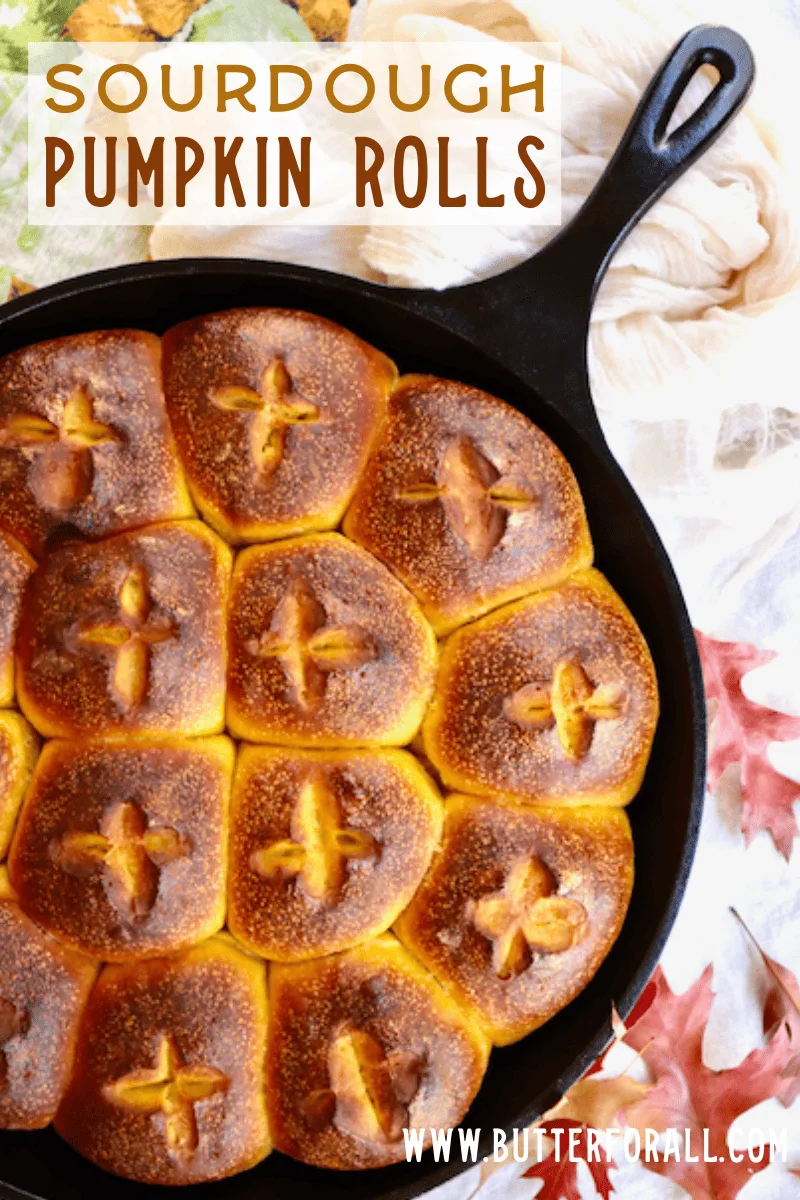
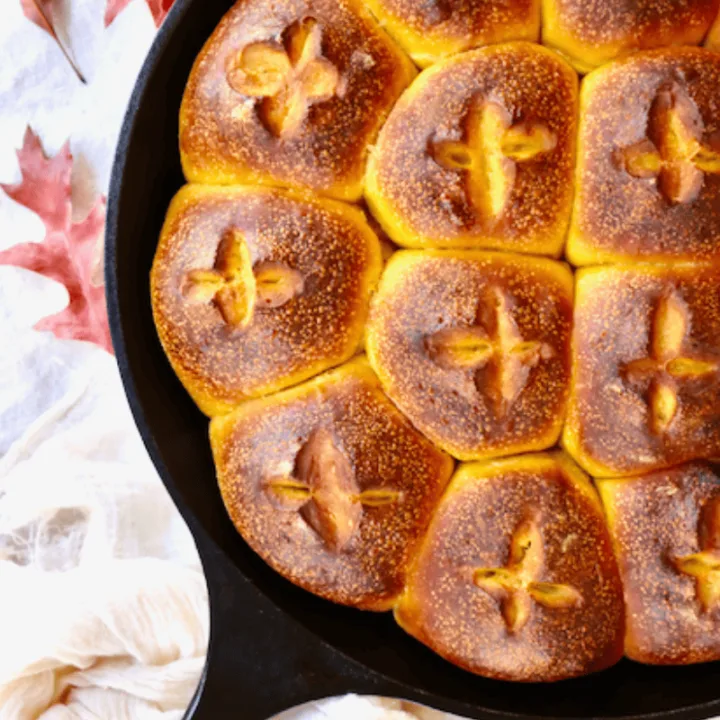
Sourdough Pumpkin Dinner Rolls
These soft and sweet sourdough pumpkin dinner rolls are the perfect accompaniment to a festive dinner spread!
Ingredients
- 520 grams (2 cups) roasted winter squash or pumpkin purée
- 250 grams (1 cup after stirring down) active sourdough starter, 100% hydration
- 3 eggs (180 grams)
- 130 grams (1/2 cup) milk
- 130 grams (1/2 cup) heavy cream
- 40 grams (1/4 cup) coconut sugar
- 15 grams (2 teaspoons) salt
- 420 grams (3 cups) organic sifted whole wheat flour (this is similar to a whole wheat pastry flour)
- 420 grams (3 cups) organic bread flour
Egg Wash
- 1 egg yolk
- 2 tablespoons water
Instructions
The Night Before (Mixing and Bulk Ferment)
- In an extra-large bowl combine the pumpkin, starter, eggs, milk, cream, sugar, and salt. Use a dough whisk to combine these ingredients well.
- Whisk in the flour until completely combined. The dough will be fairly sticky. Let the dough rest for 5 minutes.
- Using the dough whisk, do a modified stretch and fold in the bowl by lifting the dough up on one side with the whisk and folding it back over itself. Repeat this several times, turning the bowl 90 degrees every time. Let the dough rest again for 5 minutes.
- Repeat the modified stretch and fold several times, resting between each series, until the dough has become smooth and elastic.
- Cover the dough with a lid or plastic wrap and let it ferment for 8 to 10 hours (overnight) at room temperature (65 to 70℉).
The Next Morning (Shaping, Proofing, and Baking)
- Prepare your baking pans. Grease two 10-inch cast-iron skillets or one extra large casserole dish with butter.
- Generously flour your work surface.
- With wet hands gently deflate the fermented dough in the bowl by doing a gentle stretch and fold preshaping. Lift the dough and fold it over itself, turning the bowl after each fold, allowing the dough to gather in a loose ball.
- Turn the dough ball out onto the floured surface and let it rest for a few minutes.
- Flour the top of the dough lightly and start cutting twenty-four 90-gram portions. Keep each dough portion off to the side on a floured surface.
- Once the dough is cut, start shaping the dough into small tight balls. Follow the same shaping technique I demonstrate in my sourdough burger bun recipe.
- As you are shaping the rolls, add them to your prepared baking pans. There should be some space around each roll but not too much as you want them to touch each other once proofed!
- Once all the rolls have been shaped, cover the baking pans and let the rolls rise at room temperature for 1 to 3 hours or until doubled in size.
- Once doubled, preheat your oven to 375℉.
- Combine the egg yolk and water and gently brush the top and sides of each roll with egg wash, making sure to coat each roll lightly and evenly.
- Using scissors snip a little cross into the top of each roll.
- Bake the rolls uncovered for 30 minutes.
- Remove the pans to cooling racks. Serve the rolls warm or at room temperature.
- The rolls can be rewarmed in a low oven if desired.
Notes
How Do I Store the Rolls?
Because the dough contains eggs, the rolls are best stored in an airtight container in the refrigerator after the first day.
Can the Dough Be Shaped Differently?
Yes! This dough can be shaped into loaves, braids, buns, and more!
Can I Substitute Flours?
Yes! The sifted whole wheat flour in the recipe can be substituted for all-purpose flour or any other whole grain wheat flour. Just make sure you use the full amount of bread flour or the dough will not rise as intended.
Pan sizes:
Use either two 10-inch cast-iron skillets, two 8-inch by 11.5-inch by 2-inch standard casserole dishes, one large 10 by 15-inch casserole dish or one deep 15-inch skillet.
Recommended Products
As an Amazon Associate and member of other affiliate programs, I earn from qualifying purchases.
-
 Pyrex Bakeware 4.8 Quart Oblong Baking Dish, Clear
Pyrex Bakeware 4.8 Quart Oblong Baking Dish, Clear -
 King Arthur, 100% Organic Unbleached Bread Flour, Non-GMO Project Verified, No Preservatives, 2 Pounds (Pack of 12) -Packaging May Vary
King Arthur, 100% Organic Unbleached Bread Flour, Non-GMO Project Verified, No Preservatives, 2 Pounds (Pack of 12) -Packaging May Vary -
 100% Organic All Purpose Unbleached White Baking Flour - 10 Pound
100% Organic All Purpose Unbleached White Baking Flour - 10 Pound -
 Cuisinart DLC-10SYP1 Food Processor, 7 Cup, White
Cuisinart DLC-10SYP1 Food Processor, 7 Cup, White -
 Pro Dough Pastry Scraper/Cutter/Chopper Stainless Steel
Pro Dough Pastry Scraper/Cutter/Chopper Stainless Steel -
 Lodge Pre-Seasoned Cast Iron Skillet With Assist Handle, 10.25", Black
Lodge Pre-Seasoned Cast Iron Skillet With Assist Handle, 10.25", Black
Want To Learn Everything About Sourdough?
Start with this free guide:
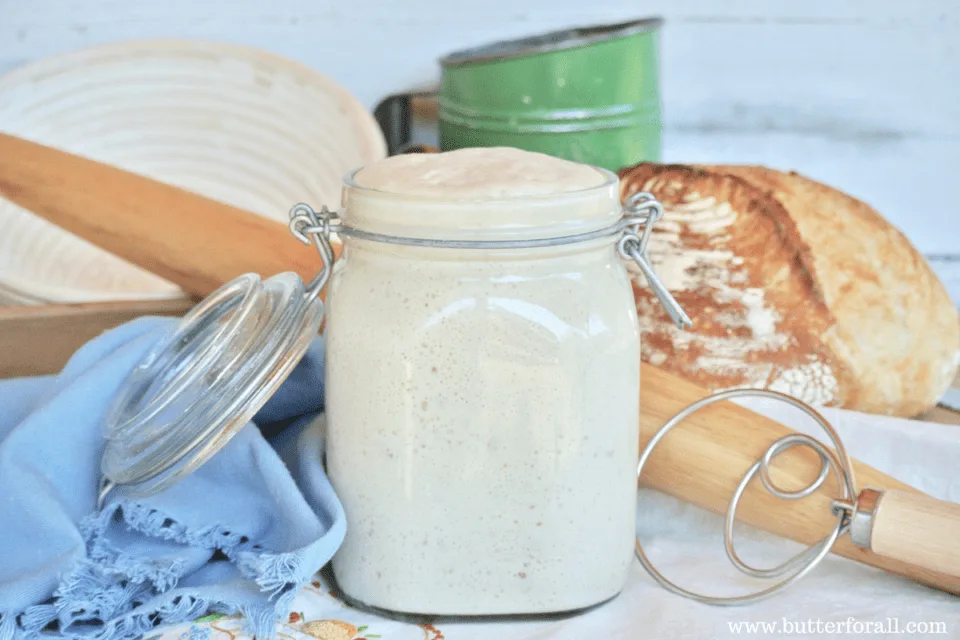

Deborah Butler
Saturday 26th of October 2024
Would this recipe work substituting gluten free sourdough starter and gluten free flour?
Butter For All
Wednesday 30th of October 2024
Hi Deborah, I should think so. You may need to adjust the hydration a little bit, just like any recipe. Just add extra flour or a little more liquid until you get the right consistency!
ticia
Wednesday 8th of November 2023
Can you use only bread flour?
Butter For All
Tuesday 12th of December 2023
Absolutely! Even more lofty!
Teresa Taylor
Wednesday 11th of October 2023
Hello there!
I found your site via pinterest a few days ago and have been reading non stop since! I'm on a mission to get healthier and your site has loads of great info! Thank you!
I'm new to sourdough. The type I make is different than traditional four and water sourdough. I've heard it called potato flake sourdough. My question is could I make this recipe with the potato flake sourdough? You have lots of good sourdough recipes that I'd love to try with my potato flake. Just wondering which ones you think would be successful. I hear potato flake is a lot more forgiving than flour and water but I often think about starting a traditional one so I can make all of these fun things! I'd love to hear what you think.
Thanks again for all of your good info!
Butter For All
Thursday 12th of October 2023
Hi Teresa!
Thank you! I love hearing your feedback.
You should be able to use your potato starter in any sourdough recipe as long as it's active and rising well. I don't foresee it changing the finished product too much!
If you wanted to play around with starting a traditional sourdough culture, you might be able to do it using a little bit of your potato starter. Just mix 25 g of organic wheat flour with 25 g of water and add 10 g of your potato starter. Over the next few days remove 50g of starter and feed the starter with the same ratio of flour and water as the first feeding until it's bubbly and doubling in in 6-8 hours.
Can't wait to hear how it goes!
Courtney
Mallory
Friday 7th of October 2022
Hi…I’m making the buns and finding the instruction about the stretch and fold confusing. Let rest 5 minutes ? Then repeat? For several hours ?? The dough is extremely wet and it feels unlikely that it will be ready to handle tomorrow morning. Am I missing something ? Thanks Mallory
Butter For All
Friday 7th of October 2022
Hi Mallory,
This dough is very soft and sticky. That's why doing the stretch and fold is so important. It builds the gluten that will end up making the dough easier to handle in the morning. If you look at step 4 it says "Repeat the modified stretch and fold several times, resting between each series, until the dough has become smooth and elastic." There is no specific time mentioned because you are looking for a texture in the dough. So you do the stretch and fold with rest periods until you've formed enough gluten for the dough to be elastic. In the recipe I also recommended using a dough whisk for your stretch and fold because this dough is so sticky. With the right gluten development, and a well balanced and cool fermentation, you should be able to handle the dough in the morning. If you aren't comfortable with the hydration you can always add a bit more flour until it's easier to work with. Hope all that helps! And hope you love the rolls!
Courtney
Margie J Hodges
Friday 29th of October 2021
I'm making this right now, however I was wondering how long, thru the stretch and fold process, did it take to become elastic? It's very wet. Seems like it might come together faster in my mixer?
Butter For All
Monday 22nd of November 2021
Hi Margie!
Sorry for the slow reply! I've been taking a little break to deal with some family and health issues. My dough usually takes a few hours to fully absorb and hydrate. I really hope the recipe worked out for you!
Courtney